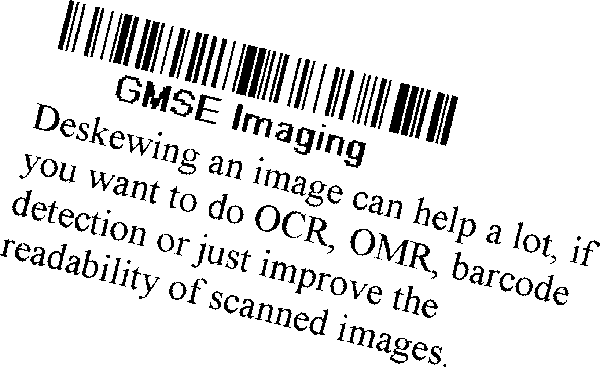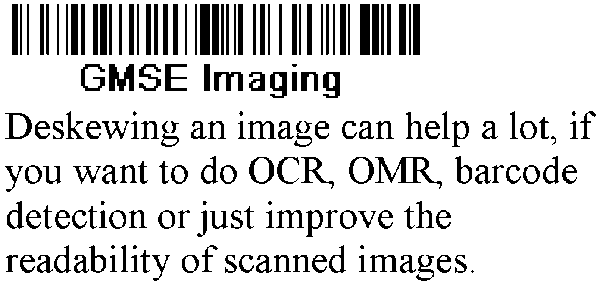Introduction
The following article describes an algorithm in VB.NET to deskew an image.
Background
Deskewing an image can help a lot, if you want to do OCR, OMR, barcode detection, or just improve the readability of scanned images. For example, think of a camera that automatically takes photos of goods with a barcode. If the skew angle is too high, the barcode can not be detected. After deskewing, the barcode can be read.
Before deskewing:

After deskewing:

Using the code
The following code determines the skew angle of the image bmpIn:
Dim sk As New gmseDeskew(bmpIn)
Dim skewangle As Double = sk.GetSkewAngle
Dim bmpOut As Bitmap = RotateImage(bmpIn, -skewangle)
Points of interest
The basic idea of the algorithm is:
- Find reference lines in the image.
- Calculate the angle of the lines.
- Calculate the skew angle as an average of the angles.
- Rotate the image.
The lines are detected with the Hough algorithm. Each point in the image can lie on an infinite number of lines. To find the reference lines, we let each point vote for all the lines that pass through the point. The lines with the highest number of points are our reference lines.
First, we need the parameterization of a line. A line can be parameterized as:
y = m*x+t
with slope m and offset t. We are interested in the angle and not the slope. The angle alpha of the line satisfies:
m=tan(alpha)=sin(alpha)/cos(alpha)
We get:
y=sin(alpha)/cos(alpha)*x+t
Which is equivalent to:
y*cos(alpha)-x*sin(alpha)=d
We can not search an infinite parameter space, so we have to define a discrete one. We search for all lines with:
-20<=alpha<=20
in 0.2 steps, and we round d to an integer.
The basic algorithm in pseudo code:
1. Create a two-dimensional matrix Hough and initialize the values with 0
2. for y=0 to Height-1
3. for x=0 to Width-1
4. if Point(x,y) is black then
5. for alpha=-20 to 20 step 0.2
6. d= Trunc(y*cos(alpha)-x*sin(alpha))
7. Hough(Trunc(alpha*5),d)+=1
8. next alpha
9. end if
10. next x
11. next y
12. Find the top 20 (alpha,d) pairs that have the highest count in the Hough matrix
13. Calculate the skew angle as an average of the alphas
14. Rotate the image by – skew angle
The algorithm is computationally expensive. To save some time, the number of voting points is reduced. For each text line, you can draw many lines with different angles through the letters:

For deskewing, only the bottom line is important.

The points on the bottom line have a lower neighbour that is white. So, we only let points (x,y) vote that satisfy:
- The point (x,y) is black.
- The lower neighbour (x,y+1) is white.
References
The article was taken from GMSE Imaging.
History
- 03-30-06: Original article.
- 03-31-06: More explanations about the Hough algorithm.
- 04-25-06: Added the References section.
